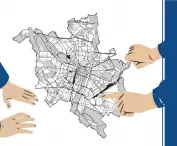Public consultations have been launched on the updated study of land use conditions and directions for Poznań. The proposed modifications are evolutionary and don't seem to have as strong a political charge as one of the previous changes to the study. There is to be more land for residential development, large-format retail is in retreat, green space is becoming more important.
"Change of the study" - this phrase has a revolutionary connotation in Poznań. The memory of the social ferment caused by the 2006-2008 update of the study is alive. Disagreement with the proposed provisions and the city's pro-developer approach resulted in a wide-ranging discussion and led to the formation of strong urban movements - associations - in the city: My Poznaniacy and - later - Right to the City. In the long run, this led to a change in the city government in the 2014 elections. Jacek Jaskowiak - first promoted by the urban movements and later elected with the support of the local PO - became the mayor of Poznań. For several years his deputy was Maciej Wudarski from the Right to the City. It is worth mentioning that the change of power occurred during the next revision of the study - in 2014.
for the fourth time
Work on the next, fourth update, however, has been underway since 2020, and is unlikely to be the catalyst for the next urban revolution. Planners have just presented the finished document, which residents can comment on until May 6. It is worth noting that work on the latest update is being carried out more efficiently and clearly than previous procedures. Information about planned transformations is communicated transparently, and opinions on the document (and even polemicizing with its provisions) were encouraged a few days ago by KO politicians. In addition, the study has been divided into 42 areas in line with the boundaries of the neighborhood councils, so that the opinion process is more efficient.
Finally, and very importantly, the Municipal Urban Planning Bureau, which was responsible for the entire work, made interesting and well-presented analyses devoted to particular spatial aspects: greenery, transportation, housing or production and commerce, among others. These analyses were discussed during meetings with groups of experts (including SARP, TUP, MKUA) at the turn of this year and last year.
green connectors
What does the modified document emphasize? You can get a sense of the nature of the changes by reading the already catchy but rather generic names of the main objectives: "Mosaic City," "City in the Green and Blue Grid," or "Back to the City." The emphasis placed on green and ecological aspects seems important. For the first time, the study indicates sites for retention reservoirs, and existing green areas are to form a coherent system with proposed natural connectors. There are also new investment fields for residential development where commercial or manufacturing functions were previously recorded. There is an apparent emphasis on further development of streetcar transportation and calming traffic in the center. However, the elimination of some areas designated for large-format retail was not without identifying new areas with this function, including in the vicinity of Ławica Airport. However, more important than such decisions seems to be the study's emphasis on creating smaller, neighborhood local-service centers.
These aspects are appreciated by Dr. Lukasz Mikula of Adam Mickiewicz University, a spatial management specialist, councilor and chairman of the City Council's Spatial Planning Commission:
Most welcome is the change in the function of the areas previously occupied by first-generation shopping centers. There is a chance that more humanized forms of development will be built in their place. Plans to create a new residential district in the east of the city: in the area of Darzybor and Michalow, also promise to be very interesting. The land there belongs to the city or the State Treasury, so there is a chance to develop space there in the spirit that guided the realization of New Żerniki.
without a riverside highway
Mikula also points to favorable transportation changes, especially within the downtown area:
The land reserve for a two-lane street along the Warta River on the outskirts of the Old Town, which was once supposed to close the so-called Stuebben Ring, the ring road of the inner city, is finally disappearing. However, I wonder about the advisability of continuing to maintain the construction of a new bridge across the river north of downtown - between Winogrady and Main streets. Running a crossing over the vast and naturally valuable areas along the Warta River is unlikely to make sense.
On the other hand, Mikula appreciates the concept of green connectors, although he notes that some of them run along streets and can in principle be implemented and without a study - as part of the activities of the City Roads Administration.
There is also another legal concern with the update. While working on the new version of the study, the government announced a profound amendment to the Land Use Law. After an absence of almost two decades, the general development plan for the municipality is to return, and the study is to perform more of an analytical function. So isn't it worth waiting for the law to be amended? Mikula answers:
On the contrary. An updated study can be a very good basis for developing a general plan. All the more so since it is not known what the deadline will be for its enactment. It would be bad if the master plan is based on assumptions that are no longer valid.














